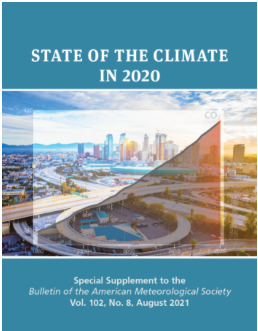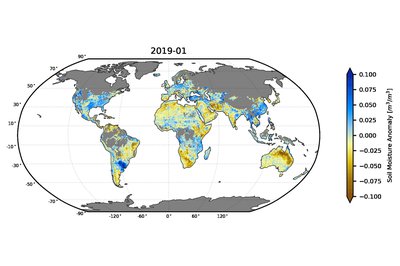6 septembre 2021
Space-based climate indicators support global ‘state of the climate’ report
Report draws on multiple satellite data products from ESA's Climate Change initiative
A new State of the Climate report, published by the Bulletin of the American Meteorological Society, provides a comprehensive global update on climate indicators and weather events in 2020.

This latest, and 31st edition, of this annual peer-reviewed series finds trends in the major indicators of climate change that are consistent with a warming planet. Many of the key characteristics of climate reported on depend on satellite missions.
Notably, the report places 2020 among the top three warmest years in records dating back to the mid-1800s. Atmospheric carbon dioxide levels have reached record levels despite significant slowdowns in economic activity during the Covid-19 pandemic.
More than 530 scientists in over 60 countries contributed to the report and reflects tens of thousands of independent datasets from instruments located on land, in oceans and lakes, as well as from satellites Earth Observations.
ESA satellite climate data
Its findings are supported by several global data records based on multiple satellite missions generated by ESA’s Climate Change Initiative (CCI). These include aerosol and cloud, ozone and sea ice – the latter being one of the clearest indicators of a warming planet. The report also draws on CCI data from the terrestrial domain, with soil moisture anomalies and observations from the world’s lakes also incorporated.

Several of the contributing authors to the report are supported by the CCI programme. Peer-reviewed publications covering ice sheets, glaciers, above ground biomass CCI projects were also cited.
In addition to record and rising levels of key greenhouse gases, the report finds that global mean sea level is rising at an average rate of 3 cm per decade. Change in sea level is broadly consistent with the CCI global satellite altimetry record (1993-2020) with the IPCC’s sixth Assessment report pointing to an acceleration in the rate of rise to 3.7mm/yr between 2008-2018. Loss of land ice from glaciers and ice sheets – which are under investigation within the CCI programme – are major contributors to of this rising trend.
Arctic sea ice decline
According to the report, the Arctic region continued to warm in 2020. Annual mean surface air temperature for the Arctic land area is the highest in the 121-year record.
Correspondingly, data for 2020 from the CCI confirms a continued decline in sea ice extent in response. September sea ice extent in 2020 covered the second smallest area of the 42-year satellite era, behind the record minima of 2012. Sea ice is also becoming younger. The thickest ice - usually more than four years old – has declined by more than 86% since 1985. This old ice made up just 2% of total ice in 2020.
Global cloudiness in 2020 increased by 0.31% relative to 2019, based on several satellite records including the CCI record. Clouds play an important role in both warming and cooling our planet but remain a major area of uncertainty. Developing this satellite-derived record via the CCI aims to strengthen the understanding of this key climatic variable.
Recently published research based on model simulations, and validated using CCI time series, suggest lakes will warm in response to climate change across the 21st Century. The State of the Climate report notes that worldwide average lake surface water temperature trends (1996-2020) are broadly consistent with the mean surface lake temperature warming trend over the previous 25 years, although globally, distinct regions of coherent warm and cool anomalies were identified in 2020.
Global surface soil moisture conditions in 2020 were on average close to the climatology derived from historical data of the 1991–2010 period. The report points to stronger regional variations in soil moisture than in previous years, with East Africa and India being especially moist.
Monitoring soil moisture conditions is key for our understanding of the climate system, due to its role in the energy and water fluxes at the land–atmosphere boundary. In addition to contributing to the 2020 edition, the CCI Soil moisture product, has contributed to this report over the past 10 years which uses data from active and passive microwave sensors from multiple satellite missions to provide global coverage from 1978-2020.
All datasets developed by the CCI are free and open access via the CCI Open Data Portal.
The State of the Climate in 2020 report is published as a special supplement to the Bulletin of the American Meteorological Society. The journal makes the full report openly available online.

